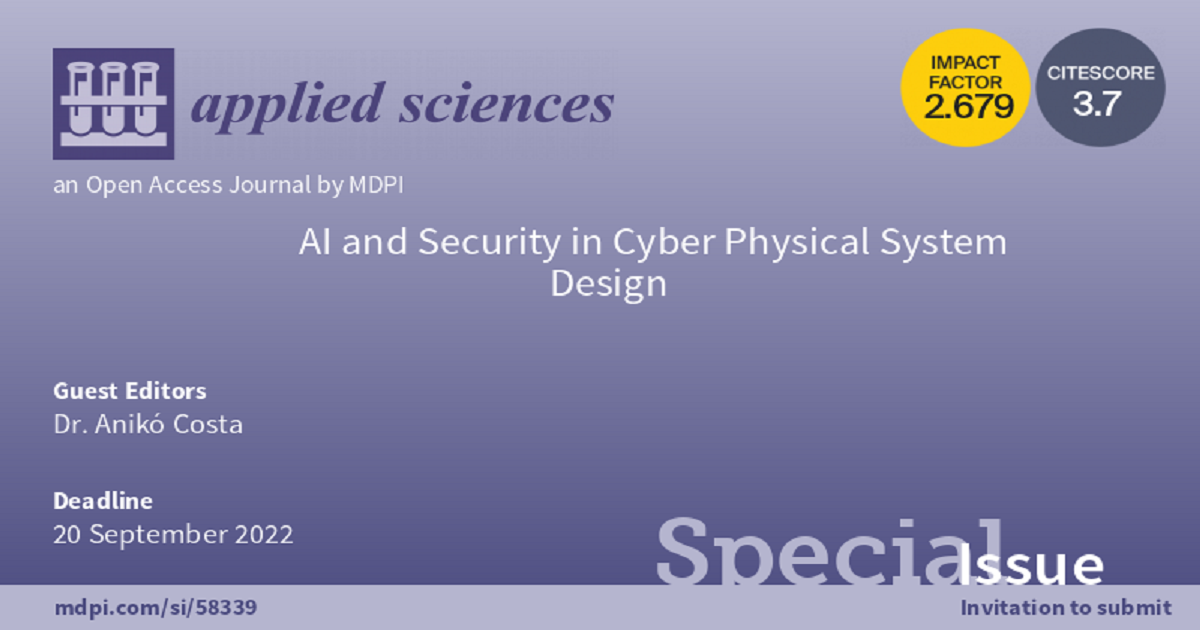- 2.5Impact Factor
- 5.5CiteScore
- 20 daysTime to First Decision
AI and Security in Cyber Physical System Design
This special issue belongs to the section “Electrical, Electronics and Communications Engineering“.
Special Issue Information
Dear Colleagues,
Cyber-physical systems (CPS) can be seen as the combination of computation, communication, and physical processes, where embedded computation and networking can control physical devices.
The combination of machines, sensors, embedded computational intelligence, and communication mechanisms allow CPS to monitor and control physical components through computer-based algorithms strongly supported by internet connectivity (Internet of Things—IoT). New sensors with computational capabilities allowing adaptive and cognitive computation are becoming the core of CPS and safety-critical systems.
Cyber-physical systems also play an essential role in industrial digitalization. Associated processes require automatized data acquisition and data storage, beyond analyses on the cloud. Having secure communication between physical devices and the cloud is a vital issue.
Continuous improvements in computational methods, artificial intelligence (AI), and communications, as well as at sensor and actuators levels, allow machines to refine their performance interacting with the surrounding environment. Adaptation and self-learning need to be present whenever fault tolerant operation and resiliency need to be considered. Cybersecurity in operation is mandatory whenever control of critical infrastructures is considered, leading to high security requirements.
Summarizing the above, it can be noticed that the current design of cyber-physical systems has to face numerous challenges when integrating the new AI methodologies, keeping security and resiliency at high levels.
Topics of interest include but are not limited to:
- Design methodologies of CPS and IoT;
- Formal analysis and verification of CPS and IoT, safety-critical systems;
- Cybersecurity aspects, including cryptographic algorithms, protocols, e-services, etc.;
- Artificial Intelligence, machine learning, and deep learning techniques applied to CPS and IoT;
- AI-based security solutions for CPS and IoT;
- Impact of AI-based solutions on CPS performance;
- Modeling of attack behavior;
- Attack prediction modeling;
- Industrial digitalization and CPS.
Dr. Anikó Costa
Prof. Dr. Remigiusz Wiśniewski
Guest Editors
Manuscript Submission Information
Manuscripts should be submitted online at www.mdpi.com by registering and logging in to this website. Once you are registered, click here to go to the submission form. Manuscripts can be submitted until the deadline. All submissions that pass pre-check are peer-reviewed. Accepted papers will be published continuously in the journal (as soon as accepted) and will be listed together on the special issue website. Research articles, review articles as well as short communications are invited. For planned papers, a title and short abstract (about 250 words) can be sent to the Editorial Office for assessment.
Submitted manuscripts should not have been published previously, nor be under consideration for publication elsewhere (except conference proceedings papers). All manuscripts are thoroughly refereed through a single-blind peer-review process. A guide for authors and other relevant information for submission of manuscripts is available on the Instructions for Authors page. Applied Sciences is an international peer-reviewed open access semimonthly journal published by MDPI.
Please visit the Instructions for Authors page before submitting a manuscript. The Article Processing Charge (APC) for publication in this open access journal is 2400 CHF (Swiss Francs). Submitted papers should be well formatted and use good English. Authors may use MDPI's English editing service prior to publication or during author revisions.
Keywords
- cyber-physical systems
- Internet of Things
- safety
- security
- embedded computing
- sensors networks
- artificial intelligence

Benefits of Publishing in a Special Issue
- Ease of navigation: Grouping papers by topic helps scholars navigate broad scope journals more efficiently.
- Greater discoverability: Special Issues support the reach and impact of scientific research. Articles in Special Issues are more discoverable and cited more frequently.
- Expansion of research network: Special Issues facilitate connections among authors, fostering scientific collaborations.
- External promotion: Articles in Special Issues are often promoted through the journal's social media, increasing their visibility.
- e-Book format: Special Issues with more than 10 articles can be published as dedicated e-books, ensuring wide and rapid dissemination.

